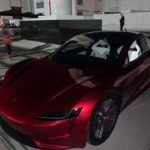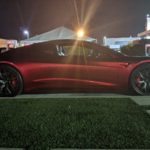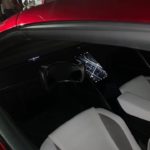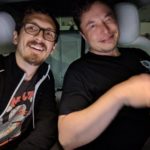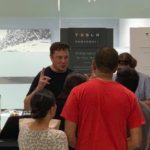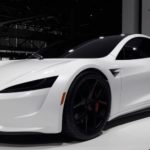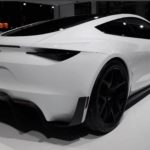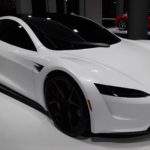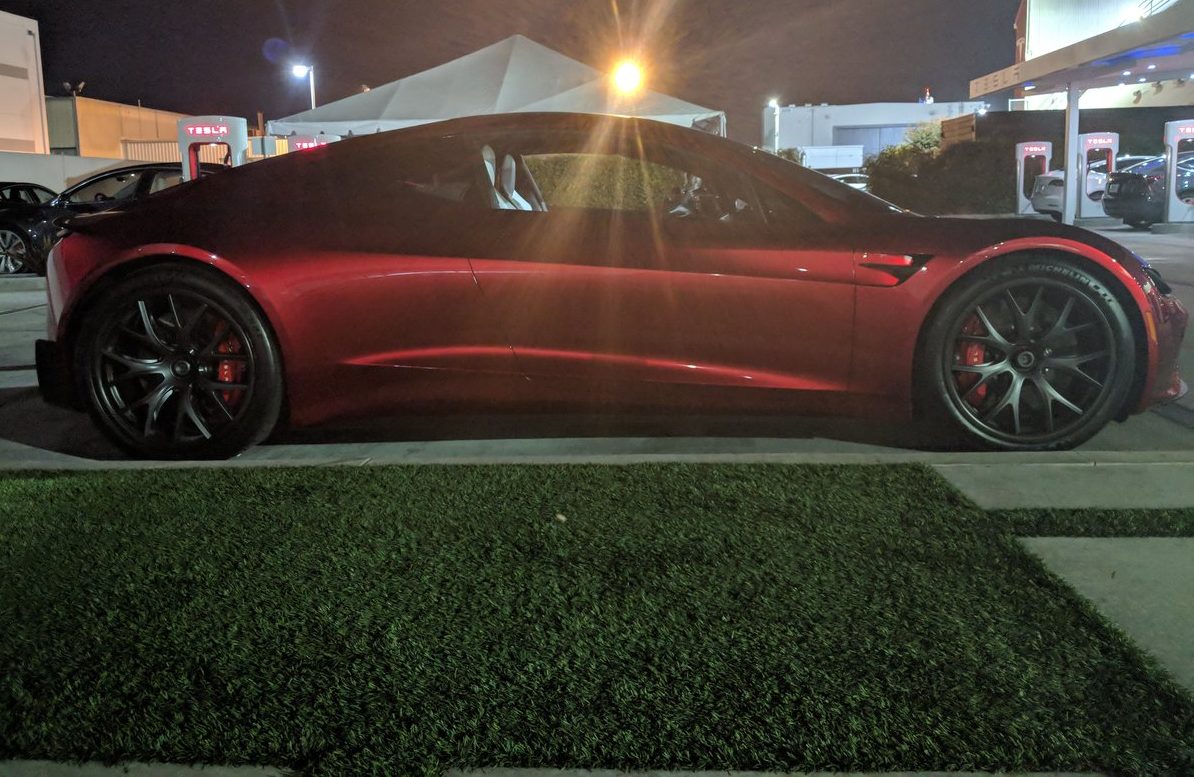
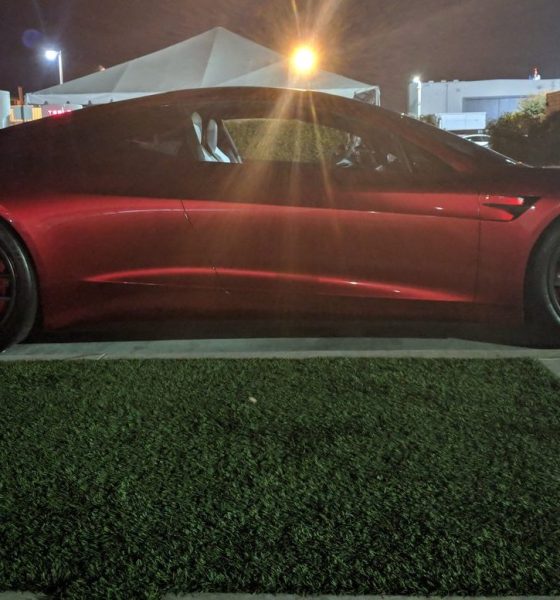
News
Next-gen Tesla Roadster makes rare appearance at Hawthorne, CA delivery site
Reservation holders who were taking deliveries of their electric cars in Hawthorne, CA were treated to a rare sight on Sunday, as Tesla brought over its upcoming halo car — the next-generation Roadster — to its delivery site.
All hands were on deck this past weekend as Tesla conducted a massive rush to deliver as many vehicles as it can to reservation holders. Employees from different departments, including some executives, reportedly helped handover electric cars. In Hawthorne, CA, Tesla’s Design Center close to SpaceX HQ seemed to have been used as a temporary delivery center. Elon Musk was on site, seemingly delivering cars himself. A SpaceX employee who received his Model 3 on the Hawthorne, CA site even shared images on Twitter depicting Elon Musk doing the handover for his car.
The next-generation Tesla Roadster attracted a lot of attention, both from those who were waiting to receive their electric cars and even SpaceX employees, whose headquarters was located nearby. The Roadster that made an appearance was the red, operational prototype that the company used for test drives during the vehicle’s unveiling, as well as in a recent segment of Jay Leno’s Garage, where the veteran host’s inner child was unleashed when Tesla Chief Designer Franz von Holzhausen launched the all-electric supercar from a dead stop.
- The next-generation Tesla Roadster on display at Hawthorne, CA. [Credit: The Tesla Life/Twitter]
- The next-generation Tesla Roadster on display at Hawthorne, CA. [Credit: Christopher Alan Stanley/Twitter]
- The next-generation Tesla Roadster on display at Hawthorne, CA. [Credit: The Tesla Life/Twitter]
- Elon Musk delivers a SpaceX employee’s Tesla Model 3. [Credit: Christopher Alan Stanley/Twitter]
- Elon Musk helps out in Tesla’s end-of-quarter deliveries. [Credit: The Tesla Life/Twitter]
The next-generation Tesla Roadster on display at Hawthorne, CA. [Credit: Christopher Alan Stanley and The Tesla Life/Twitter]
The United States is not the only country that was recently graced by the next-generation Tesla Roadster. Last month, Tesla brought the vehicle — albeit a non-operational 1:1 model — to the Grand Basel Auto Show in Switzerland. The Swiss auto show is traditionally populated by the industry’s most remarkable vehicles, and the next-gen Roadster, painted in a stunning white, fit right in with the event’s other premium automobiles.
While the next-generation Tesla Roadster would not be produced in mass quantities like the Model 3 sedan, the vehicle still has the potential to cause a small “disruption” of its own in the European market. The region, after all, is home to some of the world’s most prestigious supercar makers, including Ferrari, Bugatti, Lamborghini, Pagani, and Koenigsegg. These carmakers are known for their pedigree in creating cars that are stunning in design and insanely fast — two adjectives that can also be applied to the next-gen Roadster.
- The next-generation Tesla Roadster at the Grand Basel Auto Show.
- The next-generation Tesla Roadster at the Grand Basel Auto Show.
- The next-generation Tesla Roadster at the Grand Basel Auto Show.
The next-generation Tesla Roadster at the Grand Basel Auto Show.
In a way, Tesla’s upcoming halo car could prove to be the most bang-for-your-buck supercar in the market when it gets released. During the vehicle’s unveiling, Elon Musk announced that the next-gen Roadster would start at $200,000. That’s more affordable than mid-level supercars like the McLaren 720S and the Ferrari 812 Superfast (which are priced in the ~$300,000 range), despite having performance figures that rival (or even exceed) million-dollar halo cars like the McLaren P1 and the Ferrari LaFerrari. With this in mind, it would not be surprising if the vehicle ends up finding a strong following among supercar enthusiasts in Europe and its surrounding regions.
During its unveiling, Elon Musk stated that the whole point of the vehicle is to deliver a “hardcore smackdown” to gasoline-powered cars. Looking at the car’s specs, this definitely seems to be the case. Thanks to its three electric motors, the vehicle has a 0-60 mph time of 1.9 seconds, a 0-100 mph time of 4.2 seconds, and a top speed of more than 250 mph. Its 200 kWh battery pack also gives it an industry-leading 620 miles per charge.

Elon Musk
Elon Musk and Tesla AI Director share insights after empty driver seat Robotaxi rides
The executives’ unoccupied tests hint at the rapid progress of Tesla’s unsupervised Robotaxi efforts.

Tesla CEO Elon Musk and AI Director Ashok Elluswamy celebrated Christmas Eve by sharing personal experiences with Robotaxi vehicles that had no safety monitor or occupant in the driver’s seat. Musk described the system’s “perfect driving” around Austin, while Elluswamy posted video from the back seat, calling it “an amazing experience.”
The executives’ unoccupied tests hint at the rapid progress of Tesla’s unsupervised Robotaxi efforts.
Elon and Ashok’s firsthand Robotaxi insights
Prior to Musk and the Tesla AI Director’s posts, sightings of unmanned Teslas navigating public roads were widely shared on social media. One such vehicle was spotted in Austin, Texas, which Elon Musk acknowleged by stating that “Testing is underway with no occupants in the car.”
Based on his Christmas Eve post, Musk seemed to have tested an unmanned Tesla himself. “A Tesla with no safety monitor in the car and me sitting in the passenger seat took me all around Austin on Sunday with perfect driving,” Musk wrote in his post.
Elluswamy responded with a 2-minute video showing himself in the rear of an unmanned Tesla. The video featured the vehicle’s empty front seats, as well as its smooth handling through real-world traffic. He captioned his video with the words, “It’s an amazing experience!”
Towards Unsupervised operations
During an xAI Hackathon earlier this month, Elon Musk mentioned that Tesla owed be removing Safety Monitors from its Robotaxis in Austin in just three weeks. “Unsupervised is pretty much solved at this point. So there will be Tesla Robotaxis operating in Austin with no one in them. Not even anyone in the passenger seat in about three weeks,” he said. Musk echoed similar estimates at the 2025 Annual Shareholder Meeting and the Q3 2025 earnings call.
Considering the insights that were posted Musk and Elluswamy, it does appear that Tesla is working hard towards operating its Robotaxis with no safety monitors. This is quite impressive considering that the service was launched just earlier this year.
Elon Musk
Starlink passes 9 million active customers just weeks after hitting 8 million
The milestone highlights the accelerating growth of Starlink, which has now been adding over 20,000 new users per day.

SpaceX’s Starlink satellite internet service has continued its rapid global expansion, surpassing 9 million active customers just weeks after crossing the 8 million mark.
The milestone highlights the accelerating growth of Starlink, which has now been adding over 20,000 new users per day.
9 million customers
In a post on X, SpaceX stated that Starlink now serves over 9 million active users across 155 countries, territories, and markets. The company reached 8 million customers in early November, meaning it added roughly 1 million subscribers in under seven weeks, or about 21,275 new users on average per day.
“Starlink is connecting more than 9M active customers with high-speed internet across 155 countries, territories, and many other markets,” Starlink wrote in a post on its official X account. SpaceX President Gwynne Shotwell also celebrated the milestone on X. “A huge thank you to all of our customers and congrats to the Starlink team for such an incredible product,” she wrote.
That growth rate reflects both rising demand for broadband in underserved regions and Starlink’s expanding satellite constellation, which now includes more than 9,000 low-Earth-orbit satellites designed to deliver high-speed, low-latency internet worldwide.
Starlink’s momentum
Starlink’s momentum has been building up. SpaceX reported 4.6 million Starlink customers in December 2024, followed by 7 million by August 2025, and 8 million customers in November. Independent data also suggests Starlink usage is rising sharply, with Cloudflare reporting that global web traffic from Starlink users more than doubled in 2025, as noted in an Insider report.
Starlink’s momentum is increasingly tied to SpaceX’s broader financial outlook. Elon Musk has said the satellite network is “by far” the company’s largest revenue driver, and reports suggest SpaceX may be positioning itself for an initial public offering as soon as next year, with valuations estimated as high as $1.5 trillion. Musk has also suggested in the past that Starlink could have its own IPO in the future.
News
NVIDIA Director of Robotics: Tesla FSD v14 is the first AI to pass the “Physical Turing Test”
After testing FSD v14, Fan stated that his experience with FSD felt magical at first, but it soon started to feel like a routine.

NVIDIA Director of Robotics Jim Fan has praised Tesla’s Full Self-Driving (Supervised) v14 as the first AI to pass what he described as a “Physical Turing Test.”
After testing FSD v14, Fan stated that his experience with FSD felt magical at first, but it soon started to feel like a routine. And just like smartphones today, removing it now would “actively hurt.”
Jim Fan’s hands-on FSD v14 impressions
Fan, a leading researcher in embodied AI who is currently solving Physical AI at NVIDIA and spearheading the company’s Project GR00T initiative, noted that he actually was late to the Tesla game. He was, however, one of the first to try out FSD v14.
“I was very late to own a Tesla but among the earliest to try out FSD v14. It’s perhaps the first time I experience an AI that passes the Physical Turing Test: after a long day at work, you press a button, lay back, and couldn’t tell if a neural net or a human drove you home,” Fan wrote in a post on X.
Fan added: “Despite knowing exactly how robot learning works, I still find it magical watching the steering wheel turn by itself. First it feels surreal, next it becomes routine. Then, like the smartphone, taking it away actively hurts. This is how humanity gets rewired and glued to god-like technologies.”
The Physical Turing Test
The original Turing Test was conceived by Alan Turing in 1950, and it was aimed at determining if a machine could exhibit behavior that is equivalent to or indistinguishable from a human. By focusing on text-based conversations, the original Turing Test set a high bar for natural language processing and machine learning.
This test has been passed by today’s large language models. However, the capability to converse in a humanlike manner is a completely different challenge from performing real-world problem-solving or physical interactions. Thus, Fan introduced the Physical Turing Test, which challenges AI systems to demonstrate intelligence through physical actions.
Based on Fan’s comments, Tesla has demonstrated these intelligent physical actions with FSD v14. Elon Musk agreed with the NVIDIA executive, stating in a post on X that with FSD v14, “you can sense the sentience maturing.” Musk also praised Tesla AI, calling it the best “real-world AI” today.
